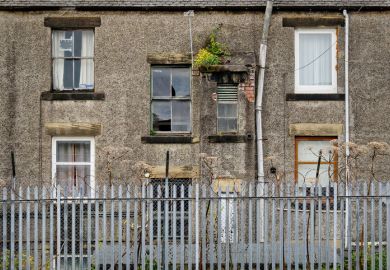Source: Corbis
Heading the agenda: although student protests in 2009 have not achieved all their aims, they have served to spur debate and influence a strategy document now under consideration by the Croatian government
In a town near the Croatian border with Bosnia, Marija Čačić saw many family members and friends lose their jobs as local industries shut down.
She came to the University of Zagreb’s philosophy department eager to lay foundations for a better life, far away from those local problems. But all that changed when Čačić joined the student movement and saw the connection between the jobless workers back home and her own struggle for “free education”.
For more than a month in 2009 students took over the department, occupying it, replacing regular lectures with public assemblies and exercising their version of direct democracy in which anyone present had a say in all decisions.
They were protesting what they saw as the growing commercialisation of education and inequality of access. Their demand was straightforward: wholly publicly funded education.
Students from some 20 faculties throughout Croatia joined the struggle, in the biggest such movement since the early 1970s.
Čačić helped to run a website, slobodnifilozofski.com, that became a platform for exchange with the rest of the world and attracted contributions from famous intellectuals and activists.
“With the occupation, we started to learn a lot and understood that the problems with education were part of a larger problem: privatisation of public goods,” Čačić says.
The debate over tuition fees has been emblematic of the wider social and economic changes undergone by Croatia in preparation for its entry to the EU in July this year. The student movement, which argues for higher education to be completely publicly funded, as it is in Finland, has had a significant impact on a strategy for the future of university funding that is about to be considered by the centre-left government of prime minister Zoran Milanović.
For many of the country’s youth, the future is bleak. Nationally, unemployment hovers at about 20 per cent. But its youth unemployment is among the highest in Europe, standing at 52 per cent in the second half of 2013, up from 25 per cent in 2009. Even for those with a degree in hand, jobs are scarce.
As the government has privatised industries and banks, the state’s budget for higher education has fallen. From 2008 to 2012, Croatia followed a trend seen across Europe’s “periphery” states: reducing public funding for higher education by up to 10 per cent, according to a European University Association study. “Core” European countries such as Austria, France, Germany, Switzerland, Poland and Sweden did the opposite.
Croatia is among those countries allocating the lowest percentage of GDP to higher education. In 2008 it was about 0.95 per cent, against a European average of 1.14 per cent. Now it is about 0.7 per cent of GDP.
Karin Doolan, an assistant professor in the University of Zadar’s sociology department, is one of the many members of the higher education community who is disturbed by these trends. She joined Akademska Solidarnost (Academic Solidarity), a group that grew out of the occupation, and in 2012 she helped to write the “Declaration on Science and Higher Education”, which lays out a vision for higher education.
The document stresses the importance of the “development of the individual as a citizen, the education of specialists, the cultural, ethical and egalitarian mission of education, education for democracy, and the strengthening of local communities”, Doolan has written.
Spurred by the student movement and the Declaration, more than 100 people from education ministry officials to teachers worked without pay to write the “Strategy of Education, Science and Technology”, outlining proposals for reform. The 180-page document, unveiled on 16 September, will be considered by the government early next year.
Neven Budak, a professor of medieval history at the University of Zagreb who headed the Strategy, says the Declaration inspired the definition of education as a public good, although it is not against the charging of tuition fees.
‘I’d like a Cadillac’
Aleksa Bjeliš has served as rector of the University of Zagreb, the largest university in the country, for seven years.
When asked whether he wanted to see education as a public good, as it is in Finland, he says: “I’d like to have a Cadillac in my garage. One thing is my wish, another is reality.”
He continues: “There is a shift from public good to something called public responsibility, which in practice means government is oriented toward trying to share the cost of studies together with the families of students.”
Tuition fees were first introduced in the 1990s, soon after the war, when about 11 per cent of the student body paid, says Andrea Milat, a former student who played a key role in the protests.

Now about 50 per cent of Croatia’s university students pay tuition fees that are among the highest in Europe, according to Eurostat, the European Union’s office of statistics.
However, the student movement has left its mark on tuition fee policy – students do not pay fees in their first year of study. And in 2010 further changes were made so that students starting their second year pay for tuition only if they have fewer than 55 credits on the European Credit Transfer and Accumulation System (ECTS) that measures student performance. The “best” students compete for fee-free places. The rest must pay.
“What that policy doesn’t take into account is that not everyone has the same chance of accumulating these ECTS points unproblematically,” says Doolan, who has a doctorate in social inequalities from the University of Cambridge, referring to issues of social equity and their impact on pre-university achievement.
One of the reasons for the credit threshold for public funding is to prevent the state from having to finance students who could remain in higher education for years or drop out of programmes – considered a poor return on state investment.
However, during the occupation, students expressed their anger at being perceived as not sufficiently motivated or intelligent to qualify for the fee-free places.
“There was all this talk about excellence,” Milat says. But “excellence” effectively means that only 10 per cent of the student population is recognised and everybody else is invalid”.
A report titled Higher Education in the Western Balkans: Reforms, Developments, Trends, published by the University of Ljubljana in Slovenia in 2013, states: “The concept of ‘good’ (the best) students and ‘bad’ students is very common across the region. It is believed that students are fully responsible for their performance and that, consequently, the academically less successful ones should not be let into the university. This hints at some sort of meritocratic elitism.”
The Strategy document argues for the preservation of the controversial ECTS-based tuition-fee scheme, although it calls for reform across the entire educational system to balance out the differences in educational achievement between schools in wealthier and poorer areas, and to extend primary education to nine years.
One of the key aims of the Strategy is to set up “programme-based contracts” between the government and higher education institutions to negotiate how much state money should be spent and how. Decisions on the number of state-funded places per field of study would be made jointly.
“Now we have a situation that many people want to study law and economics. We don’t need so many lawyers,” says Vladimir Mrša, who heads the strategic paper’s section on higher education and is vice-dean of the Faculty of Food Technology and Biotechnology at the University of Zagreb.
“This public sector should fulfil the requirements of the society. It is public, it is financed by public money and so it should fulfil the public needs,” Mrša says, adding that the report recommends focusing on science, technology and mathematics.
‘It needs to be in public hands’
But Danijela Dolenec, a London School of Economics graduate and a political scientist at the University of Zagreb who also worked on the Declaration, says: “I believe in having an education system that corrects social inequalities. For that to happen it needs to be in public hands; it can’t be run with a profit motive.”
Within higher education, the Strategy recommends more low-interest loans and scholarships for students facing economic hardship and suggests that universities create special programmes to address their needs.
“We are opening the question of whether the ministry should subsidise those or not,” says Ana Tecilazić Goršić, head of sector for the development of higher education at the Ministry of Science, Education and Sports.
“The reason behind the lack of money is insufficient political will in recognising investments in human resources as the main driver in overcoming the economic crisis,” she adds.
Although the Strategy is not legally binding, it has the potential to set the tone for reforms over the decade. It will undergo public debate for two months before government approval is sought in early 2014.
Student protesters have not secured wholly publicly funded higher education. Nevertheless, “they introduced the vocabulary of liberalisation and privatisation”, Doolan says.
“It’s not just about tuition fees. It’s a broader critique of what is seen as the predominant political and economic order.”
Register to continue
Why register?
- Registration is free and only takes a moment
- Once registered, you can read 3 articles a month
- Sign up for our newsletter
Subscribe
Or subscribe for unlimited access to:
- Unlimited access to news, views, insights & reviews
- Digital editions
- Digital access to THE’s university and college rankings analysis
Already registered or a current subscriber?





